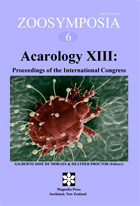Abstract
The objective of this work was to compare HMO-only foliar spray programs with grower´s usual practices for the control of the fungal pathogen greasy spot, Mycosphaerella citri Whiteside, and for suppression of arthropod pests, primarily the citrus rust mite, Phyllocoptruta oleivora (Ashmead), the pink citrus rust mite, Aculops pelekassi (Keifer), and the spider mites, Eutetranychus banksi (McGregor) and Panonychus citri (McGregor). Four cooperators with 2.38 to 5.22 hectare blocks of either ‘Hamlin’ or ‘Valencia’ oranges were switched to 224°C or 235°C horticultural mineral oil (HMO)-only foliar spray programs applied at 46.8 liters/hectare for four years. HMO applications varied from one to three applications in the test blocks per location at each year. Cooperating grower spray programs included various fungicides, acaricides, insecticides, and HMOs. First year transition from the standard fungicide-insecticide-acaricide programs resulted in active citrus rust mite development, and multiple HMO treatments were required in three of the four sites for their control. Subsequent rust mite populations in years two, three, and four did not develop in three of four sites using the HMO-only foliar spray programs. Spider mite densities in the four HMO blocks never reached levels of economic injury during any year of the study. One of the cooperators was dropped after the third (2002) season, as the test block in his property was sprayed sometime early in 2003 with a pesticide that eliminated beneficial mite populations. No secondary arthropod or disease problems developed in any of the remaining three HMO-only blocks through March 2004. The percentage of greasy spot infected leaves was significantly greater in each HMO block most years compared to the grower spray programs. However, there were no differences in leaf retention, tree canopy vigor, or yields between the HMO-only foliar spray program and the control pesticide programs. The severity of greasy spot on leaves averaged in the lowest rating category (e.g., 0 to 5%) in all treatment blocks in all years and ranged from 0.1 to 2.0% in the HMO blocks versus 0.2 to 1.5% in the control blocks. Greasy spot was effectively controlled with HMO-only treatments through the four years of this study in all orchard sites. Comparative effects between the HMO and grower spray programs on beneficial mites in the families Phytoseiidae, Stigmaeidae and Tydeidae are reported through 2002. All three mite families failed to re-establish in the four HMO-only foliar spray program blocks by the end of the third year.

